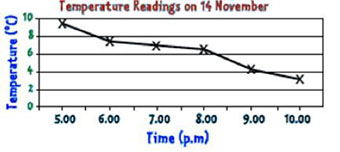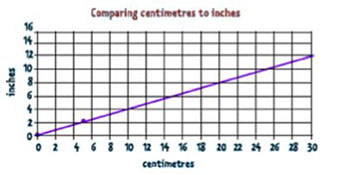Resource 2: Data handling
![]() Background information / subject knowledge for teacher
Background information / subject knowledge for teacher
Data is information. Interpreting data means working out what information is telling you.
Information in newspapers, on television, in books and on the Internet is sometimes shown in charts, tables and graphs.
It is often easier to understand the information like this rather than in writing, but it is important to read all the different parts of the graph or chart.
| Charts The title tells us what the chart is about.
You can use the chart to find out information about each bike by looking at each row in turn. The Ranger is silver and has 5 gears. |
| Name | Colour | Gears |
| Ranger | Silver | 5 |
| Outdoor | Red | 10 |
| Tourer | Blue | 15 |
| Starburst | Silver | 15 |
| Mountain | White | 5 |
Graphs Graphs come in many different styles. |
Bar graph  |
Tip: With any graph, always look carefully at:
|
Bar-line graph  |
Tip: With any graph, always check the scale. Often each division is worth more than one number. |
Line graphs Line graphs are made by joining the tops of bar-line graphs. This can make it easier to look at the shape of the graph.  This line graph shows that the temperature is falling each hour. |
Pie charts Pie charts are circular, like a pie! Each section of the pie shows a fraction of a total amount. This pie chart shows where 40 people went on their last holiday.  One quarter of the people went to Europe. That means 10 people (40 ÷ 4) people went to Europe. The UK was the most popular holiday destination. Can you work out the second most popular? |
Frequency tables A frequency table shows information about a set of data. Sometimes there is so much data that the only way to show it all is to put it into groups called intervals. This graph shows the heights of a class of children. The heights are grouped in equal intervals of 5 cm. This means that 1.30 – 1.34 includes children with heights of 1.30 m, 1.31 m, 1.32 m, 1.33 m and 1.34 m.  How many children are between the heights of 1.45 m and 1.49 m? |
Conversion graphs Conversion graphs are used to change one set of values to another. This graph converts centimetres to inches. 5 cm is approximately 2 inches.  Approximately how many centimetres are equal to 5 inches? Answers The second most popular holiday destination is the USA. There are 13 children between the heights of 1.45 m and 1.49 m. 5 inches is approximatly 13 cm |
Adapted from : BBC Schools, Website
Resource 1: Tally chart



